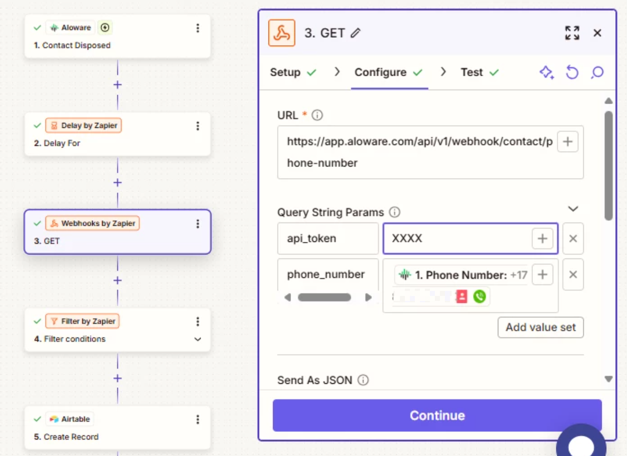Hi all, this is my first post in the community - thanks in advance to anyone that will be be trying to help me on this!
I’m having a hard time fetching some contact information after a delay in a zap. Some context:
I’m using Aloware (sms ai agent) to engage with prospects and qualify the lead. As the conversations with leads flow, the qualification changes (interested/not interested/etc). So I set up a zap that every time the qualification changes, filters the interested leads and sends them to our crm. To give time for the conversation to end and work on the final qualification outcome only, I set a delay after the zap is triggered, to do the filtering.
What I need to do - and am struggling - is to re-check the lead qualification after the delay. I tried setting up a webhook to fetch the contact information, but I’m not receiving any response. I found the following information in Aloware’s site:
Lookup up a contact using phone number
GET /api/v1/webhook/contact/phone-number
Required Query Parameters:
api_token, phone_number
Example GET URL:
https://app.aloware.com/api/v1/webhook/contact/phone-number?api_token=[API_TOKEN]&phone_number=8181234567
Returns an HTTP 200 response if a contact is found with the contact information
Returns an HTTP 400 on failure with a detailed response, Example failure response:
{
"error": "Phone number is empty or invalid."
}Returns an HTTP 404 on failure with a detailed response, Example failure response:
{
"error": "Contact not found."
}cURL Example:
curl --location --request GET 'https://app.aloware.com/api/v1/webhook/contact/phone-number?api_token=[API_TOKEN]&phone_number=8181234567'
Right now my workflow looks like this:

I hope some good heart can help!
Thanks
Lucas
This post has been edited by a moderator to remove personally identifiable information (PII). Please remember that this is a public forum and avoid sharing personal or potentially sensitive details.



